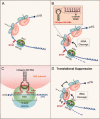Similarities between Argonautes and the alpha-sarcin-like ribotoxins: Implications for microRNA action
- PMID: 20512980
- PMCID: PMC2895252
- DOI: 10.1002/pro.391
Similarities between Argonautes and the alpha-sarcin-like ribotoxins: Implications for microRNA action
Abstract
We report structural, functional, and biochemical similarities between Argonautes, the effector proteins of RNA-induced silencing complexes (RISCs), and alpha-sarcin-like ribotoxins. At the structural level, regions of similarity in the amino acid sequence are located in protein loops both in the ribotoxins and in the Argonautes. In ribotoxins, these protein loops confer specificity for a highly conserved segment of ribosomal RNA, the Sarcin-Ricin-Loop (SRL) that undergoes cleavage by the ribotoxin ribonuclease. This leads to suppression of translation. In addition to the structural similarity with ribotoxins, the Argonaute proteins (Ago) show both functional and biochemical parallels. Like the ribotoxins, the Agos exhibit ribonuclease activity and like the ribotoxins, translational suppression mediated by miRISC-resident Ago is accompanied by intact polysomes. Furthermore, in both translationally suppressed systems, the puromycin reaction, reflecting correct translocation and peptidyl-transferase activities, is unharmed. These findings support a mechanism for Ago-miRISCs whereby regulated cleavage of ribosomal RNA leads to translational suppression.
Figures



Similar articles
-
Purification, characterization and cytotoxicity assessment of Ageritin: The first ribotoxin from the basidiomycete mushroom Agrocybe aegerita.Biochim Biophys Acta Gen Subj. 2017 May;1861(5 Pt A):1113-1121. doi: 10.1016/j.bbagen.2017.02.023. Epub 2017 Feb 20. Biochim Biophys Acta Gen Subj. 2017. PMID: 28232091
-
VapC20 of Mycobacterium tuberculosis cleaves the sarcin-ricin loop of 23S rRNA.Nat Commun. 2013;4:2796. doi: 10.1038/ncomms3796. Nat Commun. 2013. PMID: 24225902
-
Endogenous RNA cleavages at the ribosomal SRL site likely reflect miRNA (miR) mediated translational suppression.Biochem Biophys Res Commun. 2011 Nov 4;414(4):706-11. doi: 10.1016/j.bbrc.2011.09.140. Epub 2011 Oct 6. Biochem Biophys Res Commun. 2011. PMID: 22001924
-
Fungal ribotoxins: molecular dissection of a family of natural killers.FEMS Microbiol Rev. 2007 Mar;31(2):212-37. doi: 10.1111/j.1574-6976.2006.00063.x. Epub 2007 Jan 23. FEMS Microbiol Rev. 2007. PMID: 17253975 Review.
-
Ribotoxin recognition of ribosomal RNA and a proposal for the mechanism of translocation.Trends Biochem Sci. 1992 Jul;17(7):266-9. doi: 10.1016/0968-0004(92)90407-z. Trends Biochem Sci. 1992. PMID: 1502728 Review.
References
-
- Lamy B, Davies J, Schindler D. The Aspergillus ribonucleolytic toxins (ribotoxins) Targeted Diagn Ther. 1992;7:237–258. - PubMed
-
- Endo Y, Wool IG. The site of action of alpha-sarcin on eukaryotic ribosomes. The sequence at the alpha-sarcin cleavage site in 28 S ribosomal ribonucleic acid. J Biol Chem. 1982;257:9054–9060. - PubMed
-
- Endo Y, Mitsui K, Motizuki M, Tsurugi K. The mechanism of action of ricin and related toxic lectins on eukaryotic ribosomes. The site and the characteristics of the modification in 28 S ribosomal RNA caused by the toxins. J Biol Chem. 1987;262:5908–5912. - PubMed
-
- Endo Y, Tsurugi K. RNA N-glycosidase activity of ricin A-chain. Mechanism of action of the toxic lectin ricin on eukaryotic ribosomes. J Biol Chem. 1987;262:8128–8130. - PubMed
Publication types
MeSH terms
Substances
LinkOut - more resources
Full Text Sources
Other Literature Sources
Miscellaneous

